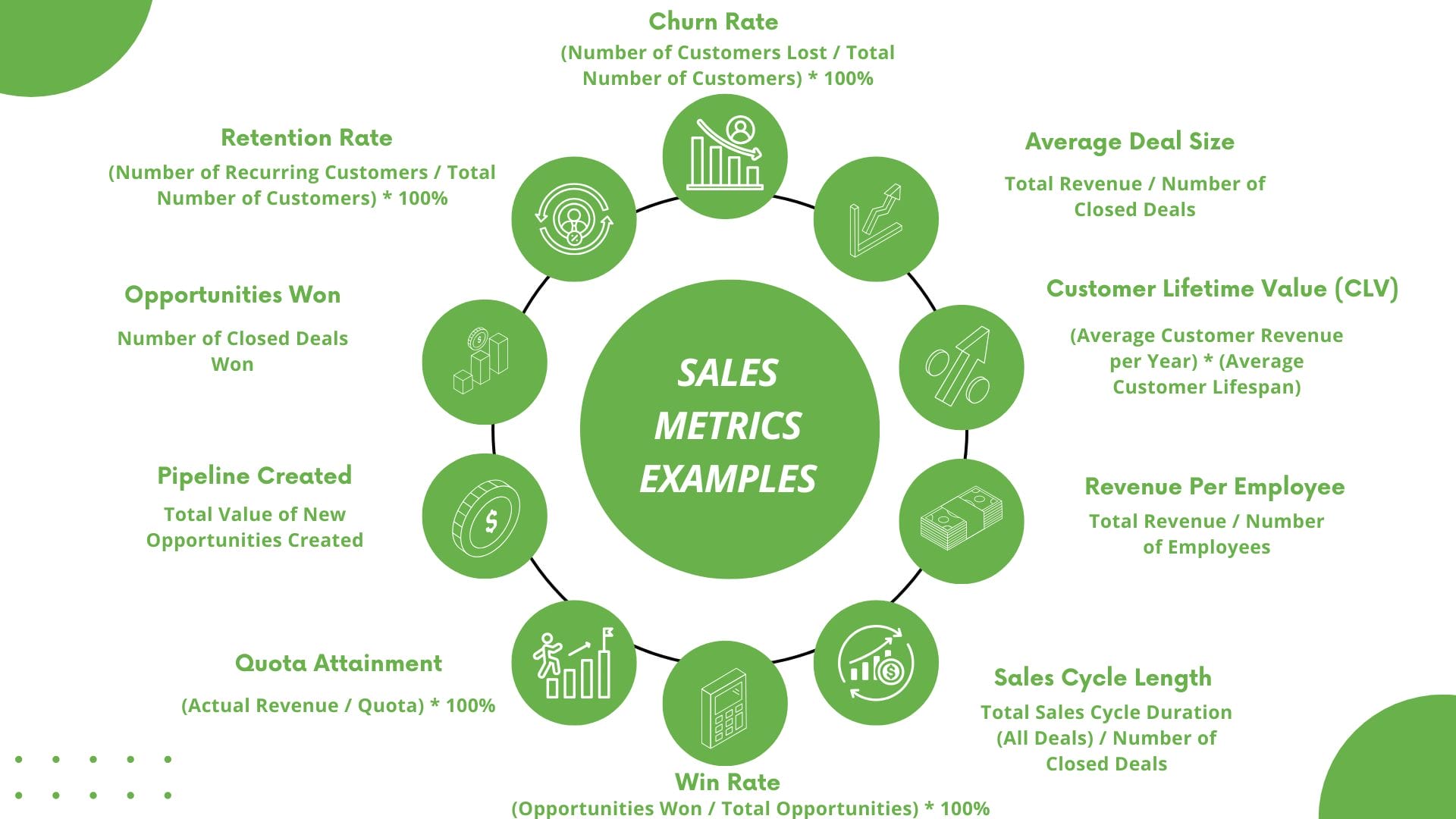Sales metrics go beyond numbers; they are a crucial indicator of your business’s well-being. By monitoring sales analytics and tracking sales performance metrics, your revenue team eliminates guesswork regarding your company’s performance.
However, knowing where to start is challenging, given the many sales metrics available. In this article, we’ll delve into the 10 essential sales metrics examples every business should track, with definitions and measurement methods for each.

What is Sales Analytics?
Sales analytics involves systematically analyzing sales data and performance metrics. It examines key performance indicators (KPIs) such as revenue, conversion rates, customer acquisition costs, and sales team efficiency. The goal is to gain insights into the effectiveness of a company’s sales strategies and activities for both the sales and marketing teams.
Sales analytics uses advanced tools and technologies that enable businesses to identify trends, forecast future sales, and optimize their sales processes. This data-driven approach allows organizations to make informed decisions, enhance sales performance, and achieve greater profitability.
By using sales analytics, companies can refine their strategies. They can also tailor their approaches to customer needs and stay agile in a competitive market.
10 Key Sales Metrics to Measure in 2024
1. Quota Attainment
Quota attainment measures the percentage of a salesperson or team’s assigned sales quota achieved during a specific period. It indicates how successful they are at meeting their revenue targets.
(Actual Revenue / Quota) * 100%
2. Opportunities Won
Opportunities won tracks the total number of sales opportunities successfully converted into closed deals during a set sales period.
Number of Closed Deals Won
3. Win Rate
Win rate measures the percentage of sales opportunities progressing to closed deals.
(Opportunities Won / Total Opportunities) * 100%
4. Sales Cycle Length
Sales cycle length tracks the average number of days for a sales opportunity to move from initial contact to a closed deal.
Total Sales Cycle Duration (All Deals) / Number of Closed Deals
5. Average Deal Size
Average deal size calculates the average revenue generated from each closed deal during a specific period.
Total Revenue / Number of Closed Deals
6. Pipeline Created
The pipeline created tracks the total value of new opportunities added to the sales pipeline during a set timeframe.
Pipeline Created = Total Value of New Opportunities Created
7. Customer Lifetime Value (CLV)
Customer lifetime value (CLV) Predicts the average revenue a customer will generate throughout their relationship with a company.
(Average Customer Revenue per Year) * (Average Customer Lifespan)
8. Retention Rate
Subscription Business: Subscription-based retention rate measures the percentage of active customers who renew their subscriptions during renewal.
Non-Subscription Models: For non-subscription models, the retention rate tracks the percentage of customers who make repeat purchases within a defined timeframe.
(Number of Recurring Customers / Total Number of Customers) * 100%
9. Churn Rate
The churn rate measures the percentage of customers who stop doing business with a company during a specific period.
(Number of Customers Lost / Total Number of Customers) * 100%
10. Revenue per Employee
Revenue per employee calculates the average revenue generated per employee during a specific period.
Total Revenue / Number of Employees
Looking for SaaS-specific metrics? Read our article, “SaaS Sales: Navigating Unique Products, Commissions, and Metrics For Success.”
How to Track the Right Sales Metrics for Growth
Consistent sales growth requires mastering the skill of tracking and measuring the right metrics for your team’s sales performance. But how do you choose which metrics to measure? Here are some tips:
- Align Metrics with Goals: Define overarching business objectives and identify KPIs directly impacting them, such as revenue, conversion rates, CAC, and CLV.
- Leverage Data Analytics: Embrace advanced tools for efficient data gathering, analysis, and generation of insightful reports.
- Monitor and Adapt: Regularly assess the effectiveness of sales strategies and adjust metrics based on evolving market dynamics or internal priorities.
- Empower Sales Team: Ensure accurate data capture by providing tools and training for proper data recording practices.
- Embrace an Iterative Approach: Periodically review and refine chosen metrics, staying agile to adapt to changing conditions for long-term success.
The Bottom Line
By strategically implementing these ten essential sales metrics in 2024, you can transform your business from reactive to proactive. As you navigate the dynamic business landscape, these metrics will guide your decision-making and allow your team to make strategic, informed choices, ensuring a competitive edge and long-term success.
To learn more about sales tips, visit our blog.
Looking to hire new sales talent? Check out our recruiting page.



